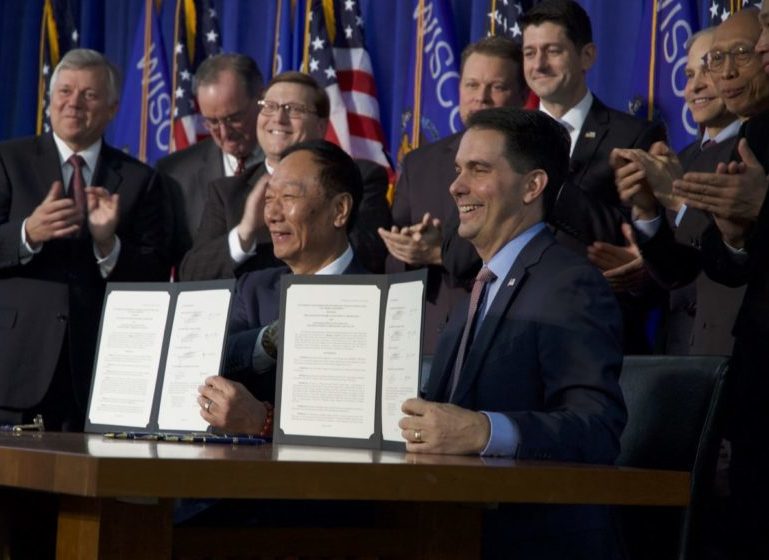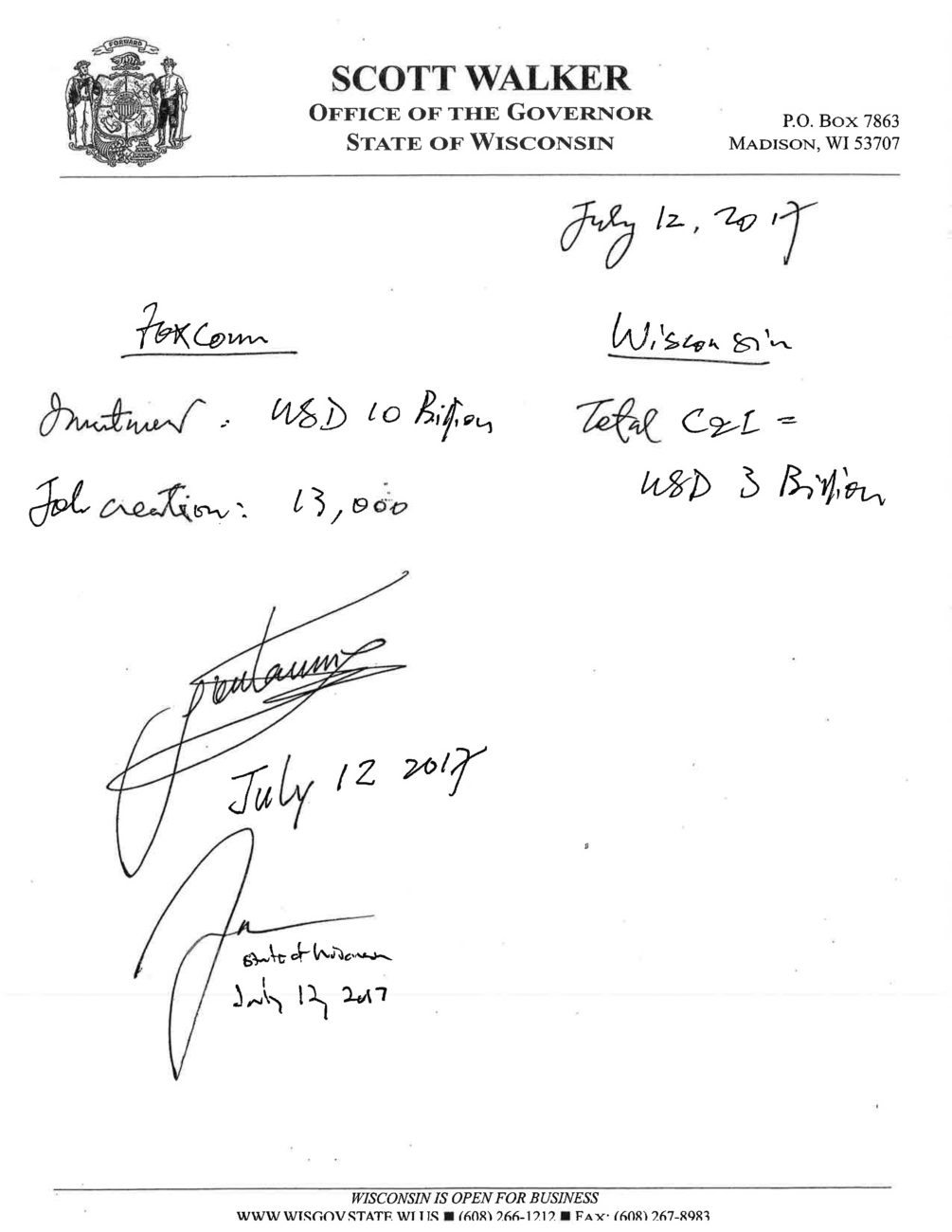Documents released by the Wisconsin Economic Development Corp. provide new insight into Foxconn’s planned wages for its Mount Pleasant operations, the company’s financials and its wish list as it selected a site.

The documents, released Friday afternoon after Gov. Scott Walker and Foxconn chairman Terry Gou signed a contract committing the state to $3 billion in tax breaks and credits, include the signed contract, the staff review compiled by WEDC, Foxconn’s application for tax credits, guarantees from Gou and Foxconn companies, and the request for proposal for Project Flying Eagle, the Foxconn code name for its U.S. investment.
The staff review, an internal WEDC document that forms the basis of the contract, outlines the rationale for approving tax credits for the company.
The document points to the project generating $116 million to $157 million in state tax revenue annually once fully operational, $330 million in state revenue during construction and $1.4 billion in spending with Wisconsin suppliers as strengths of the project.
It also notes Hon Hai Precision, the publicly traded company behind the Foxconn brand, has a strong cash position and low debt ratio “indicating the ability to obtain future financing as it relates to future projects.”
The contract requires Foxconn to use “commercially reasonable efforts” to give WEDC information on its supply chain investment in Wisconsin, but it also adds “the Recipients have no affirmative obligation under this Agreement to make a certain supply chain investment.”
The projected state tax revenues are the result of analysis by Ernst and Young and Baker Tilly. Both tried to project the number of indirect and induced jobs the Foxconn project would create. Using different methodologies and assumptions, Ernst and Young projected the state would break even in 25 years and Baker Tilly projected a 20 year break even period.
WEDC performed its own return on investment analysis, limiting its study area to 21 counties in southern Wisconsin and only accounting for state income tax as a revenue source. That analysis showed the project would generate $188 million in taxes during construction and $57 million annually once fully operational. Those figures are substantially lower than the Ernst and Young and Baker Tilly projections and would suggest a much longer payback period for the state.
The staff review notes that different methodologies generate different outcomes, but it adds “among the two primary economic impact studies issues, there is consensus that the benefit to the State of Wisconsin will be substantial, although the payback period is expected to exceed the life of the contract.”
The long payback period is listed as one of the weaknesses of the project and the staff review notes that it extends beyond the 15-year period of the contract. Other concerns included the timing of property acquisitions, a net loss for a Foxconn subsidiary in 2016 and Foxconn’s low profit margins compared to industry benchmarks. WEDC’s review put Foxconn’s gross profit margin at 7.4 percent, compared to an industry range of 26.5 percent to 35.6 percent.
“It is unknown how the new U.S. manufacturing facility and its operations will affect these rations,” the review says.
Wages and financials

As for the LCD campus itself, Foxconn is projecting it will generate $7 billion in revenue annually once up and running. Foxconn had $135.4 billion in revenue during its last fiscal year.
The company provided financial projections for the first three years of operations at the facility. Foxconn is expecting to generate $233 million in revenue and a net loss of $11 million from the campus next year as it relocates some assembly operations to Wisconsin. Revenues would increase to $1.02 billion in 2019 and $2.07 billion in 2020 while the net loss would grow to $38 million and then $220 million as interest expenses begin.
Assembly operations are expected to account for much of the revenue in the initial years of the operations. AFE Inc., one of three Foxconn subsidiaries included in the contract, will be responsible for the assembly work.
AFE is projected to account for the vast majority of Foxconn’s planned 13,000 jobs. The staff review lists the subsidiary as having 9,000 employees by 2022 with an average starting wage of $23.02 per hour. As a full-time position, that wage would equate to roughly $47,880 per year.
Foxconn will also pay 100 percent of individual health insurance premiums, including dental and vision, according to the staff review. The company will pay for half of family insurance premiums.
Other benefits will include life insurance, long- and short-term disability, a 401(k) retirement plan, 15 days of paid time off per year for the first five years and 10 holidays per year.
Foxconn is required to have an average salary of $53,875 plus benefits to receive tax credits for job creation from WEDC. Critics of the deal have often questioned how much the company would actually pay its entry level employees, suggesting higher paying engineering and corporate positions would be used to inflate the average.
Hourly operators, the lowest paying position listed in the staff review, have the same $47,880 annual salary as the AFE employees. The company plans to hire 400 people for that position next year and 4,995 by 2020. Foxconn’s request for proposal says the position requires a high school degree and will focus on machine or equipment operation along with product assembly, testing and packaging.
The next lowest paying position, equipment technician, has an average starting salary of roughly $54,720 and requires vocational school or above. Foxconn plans to hire 292 people for the position next year and 3,655 by 2022.
Foxconn is planning to ultimately hire 650 integration engineers and 2,350 process equipment engineers by 2022. Those positions require a bachelor’s degree and two years of relevant experience, according to the RFP document. The starting salary for those positions will be $58,820.
The 480 computer-integrated manufacturing engineers Foxconn plans to hire by 2022 will have a starting salary of almost $62,820. Those positions require a bachelor’s degree and at least one year of relevant experience.
An aggressive timeline
The request for proposal document, sent by Ernst and Young to WEDC on May 15, also provides additional insight into what Foxconn asked of states trying to land the project.
The RFP included plans for two different LCD plants. The first, FAB 868, is to be a generation 6 LCD plant that will make LCD panels for vehicles, aerospace, smaller televisions, notebooks and tablets. WEDC redacted information about that project’s job creation and capital investment targets.
FAB 818, the project Wisconsin ultimately landed, is described as a generation 10.5 LCD factory that would make panels for large televisions, interactive whiteboards and other large format applications. The company projected that project would include a $6.1 billion investment and create 8,800 jobs.

In addition to FAB 818, Wisconsin also landed some of Foxconn’s planned advanced manufacturing investments, which are not discussed in detail in the RFP.
The document says cost of doing business, speed with which the project could move forward and available talent would be the three main factors in determining where the projects would go.
Foxconn’s RFP says the $10.3 billion investment for the two U.S. facilities would cost about $7.3 billion in east Asia.
As for speed, the RFP says “the company has an accelerated timeline and will need to be able to expedite the permit and other administrative approval processes in order to meet the company’s operational goals. At one point in the document the company said it would be important to secure a written offer and formal approval of business incentives and finalize real estate purchase and sale terms from the candidate locations by June 30.
Foxconn also expected state and local officials to help with the development of pre-employment training programs and recruiting and screening of potential hires.
The RFP said consideration would be given to states that agreed to reimburse the company for all costs related to recruiting, relocation and training.
The company encouraged states “to be creative in their responses” and suggested help with procurement or free or discounted land might be potential options to help overcome costs differences. Foxconn also sought to have a project management office made available by July 1 and asked for a dedicated project coordinator to be identified at the state and local level.

